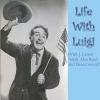
Broadcast History: 21 September 1948 to 3 March 1953
Theme Tune: Chicago by the full orchestra, blending into an Italian sounding Oh, Marie on accordion
At 9pm on Tuesday 21st September 1948 the first episode of Life of Luigi was broadcast. A week earlier the Bob Hope Show had returned to the air at exactly the same time on Tuesday nights. This meant that the creator and producer Cy Howard was going head-to-head with one of the most popular radio shows of all time. How could it possibly compete?
Before becoming one of radio’s success stories with My Friend Irma and Life of Luigi Cy Howard had been a chronic introvert who had made a pact with himself to turn his life around. He left his job as a salesman and took on various positions at local radio stations such as KTHR in Houston and WBBM in Chicago. In 1946 he arrived at CBS with the idea for My Friend Irma at the front of his mind. The show was a huge success on radio and quickly moved to TV.
Feeling confident Cy started work on Life with Luigi. The show was originally called The Little Imiigrant, but the name was changed before the first broadcast. The lead character was a recent Italian immigrant called Luigi Basco played wonderfully by J. Carrol Naish, an Irishman in real life. Luigi had moved from Rome to run an antique shop next to Pasquale’s Spaghetti Palace in the Little Italy section of Chicago and the stories revolved around his efforts to discover and integrate into his new environment.
There are very few characters and only three major locations (the antique shop, the Spaghetti Palace, and the night school which Luigi attends). The plots are far from complex, but they provide an excellent vehicle for mirth and merriment.
All in all Life of Luigi is a classic and much underrated radio comedy. It has stood the test of time far better than many of its contemporaries and in my opinion is as funny today as it ever was.
If you need some light-hearted relief then you won’t go far wrong with Life of Luigi. It certainly gave Bob Hope a run for his money back in the late 1940s.